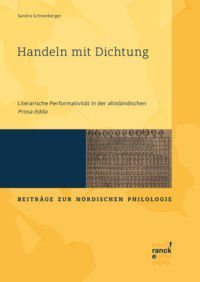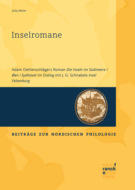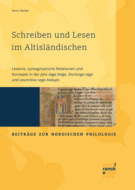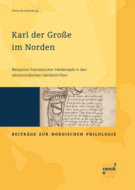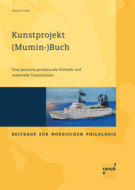Kitabı oku: «Handeln mit Dichtung», sayfa 20
4.4.3 Zwischenfazit
Pálsson sagt, es sei absurd, sich vorzustellen, das Gedicht Ht sei mit dem Kommentar an den Hof gebracht worden, da das absolut unhöflich gegenüber den Herrschern gewesen wäre. Doch die Lektüre zeigt, dass das nicht zwingend der Fall sein muss. Im 13. Jahrhundert wird im Norden die Gelehrsamkeit als zentrales Merkmal kultureller Geltung hervorgehoben. Mythologisches wird mit mythographischen Verfahren erfasst und bearbeitet, in vergleichbarer Weise muss auch die Skaldik als kulturelle Praktik auf einer diskursiven Ebene behandelt werden. Der Wert des Gedichts wird durch den Kommentar gesteigert und dient dazu, den Strophen die Überlieferung zu sichern. Der Anspruch, eine aktuelle, innovative und gleichzeitig bleibende Abhandlung der traditionsreichen Dichtung zu bieten, ist im Text durchgängig zu finden. Das macht eine Übergabe des Gedichts in schriftlicher Form mit Kommentar denkbar, obschon keinerlei Hinweise existieren, dass und wie das Werk nach Norwegen gelangt ist.
Zu Beginn des Kapitels wurde die Frage gestellt, ob der performative Sprechakt von Ht geglückt sei. In Bezug auf die wertschätzende Aufnahme am norwegischen Hof und eine mögliche Entlöhnung lässt sich das – wie gesagt – nicht bestimmen. Nimmt man hingegen die didaktische Intention des Gedichts in den Blick, so kann man durchaus von einem geglückten Akt sprechen. Im Mittelalter ist die Dichtungsterminologie noch nicht gefestigt, wird aber in verschiedenen Texten diskutiert und reflektiert. Diese aktualisierenden Wiederholungen führen schliesslich zu einer Lexikalisierung und immer stabileren Begrifflichkeiten. So sprechen wir heute noch von Dróttkvaett – ohne Ht (und ähnliche Texte) würden wir das nicht in gleichem Masse tun.
4.5 Fazit Liber secundus
Auch die Lektüren von Liber secundus zeigen eine enzyklopädische Grundtendenz – jedoch besteht diese nicht in der Aufgabe, die „Welt“ zu erfassen, sondern das Medium der Welterfassung selbst – die Sprache. Wer die Welt ordnen will, muss ein angemessenes Verständnis sprachlicher Zusammenhänge und Vorgänge besitzen. Liber secundus interessiert sich für die Ebene der Silbe ebenso wie für die Ebene der dichterischen Umschreibungen: Beide sind zentral, um das Potenzial von sprachlichen Äusserungen zu erfassen und (in diesem Fall) skaldischer Dichtung Bedeutung zu verleihen.
In Liber primus wird dem Skalden mit dem Mythos vom Dichtermet eine hohe gesellschaftliche Stellung durch die göttliche Herkunft der Dichtung zugeschrieben: Dichten kann man nicht lernen, diese Fähigkeit hat man oder nicht. Nur wer sie besitzt, erhält vom Dichtermet. Allerdings ist die mythologische Erzählung in den komplexen literarischen Täuschungsrahmen von Gylf eingebunden, somit wird nicht eindeutig klar, wie man sie einordnen soll.
In Liber secundus scheint Vorstellung von der Dichtung als Fähigkeit oder Kunstfertigkeit (íþrótt) stärker betont: Dichten ist etwas, was man lernen kann, indem man sich Kenntnisse verschiedenster Techniken und Inhalte aneignet – wie z.B. mit Hilfe der Texte von Liber secundus, das derartige pragmatische Texte zusammengestellt. Aber die vielen impliziten und expliziten Momente der Selbstreflexion zeigen, dass es dabei über didaktische Absichten und den Erhalt der traditionellen Skaldik hinausgeht: Skaldische Dichtung wird neu als Medium positioniert, um über Sprache und deren Möglichkeiten und Grenzen in theoretischer Hinsicht nachzudenken.
Liber secundus ist auch ein Zeugnis für die mediale Dynamik, mit welcher der Verfasser von U umgehen muss. Die multimediale Umsetzung der einzelnen Inhalte hat einen experimentellen Charakter und lenken den Blick darauf, dass es sich nicht um die Vermittlung von feststehenden Wissensbeständen handelt, sondern um eine Momentaufnahme eines sprach- und medientheoretischen Denkprozesses. Wissen wird einerseits neu generiert in den Texten von Liber secundus, andererseits wird auch reflektiert, wie dieses neue Wissen am besten mit Sinn aufgeladen werden kann.
5 Abschluss und Ausblick
Das Ziel dieser Arbeit war, die Prosa-Edda einer ganzheitlichen und systematischen Lektüre zu unterziehen. Das Werk sollte als Form kultureller Sinnstiftung in seiner ganzen Vielfältigkeit bzw. Mehrdeutigkeit gelesen werden, um so einen neuen Blick auf den wichtigsten sprach- und dichtungstheoretischen Text des nordischen Mittelalters zu erlangen. Dabei wurde von der Leitthese ausgegangen, dass die P-E nicht nur ein Lehrwerk für skaldische Dichtung ist, sondern sich umfassend und mit einem sprach- und medientheoretischen Ansatz für Sprache, Erzählen und Dichtung interessiert. Diese These bestätigte sich durch die verschiedenen Lektüren für die Version der P-E im Codex Upsaliensis: Didaktische Verfahren und Inhalte finden sich in dieser Handschrift aus dem Jahr 1300 ebenso wie diskursive Momente, die eine Reflexion der zu vermittelnden Wissensbestände sichtbar machen. Häufig überschneiden sich die beiden Bereiche auch, was sich auch in der enzyklopädischen Grundtendenz von U bemerkbar macht: So soll die Welt in möglichst allen Bestandteilen erfasst und eingeordnet werden, wozu es Namen bzw. Definitionen für die verhandelten Phänomene braucht. Aber nicht nur die verschiedenen Inhalte werden in U zusammengestellt und systematisiert, auch unterschiedliche mediale Vermittlungsarten werden nebeneinandergestellt: Prosatexte, mit und ohne Verszitate, listenförmige und diagrammatische Darstellungen sowie figürliche Illustrationen stellen selbst eine Art Sammlung literarischer Gattungen dar.
U umfasst aussergewöhnliche und einzigartige Umsetzungen von Texten und Stoffen und scheint medialen Experimenten nicht abgeneigt. Dieses Ausprobieren der neuen Möglichkeiten im Umgang mit Sprache macht auf die sprachphilosophische Dimension der P-E aufmerksam. In der Gesamtsicht betrachtet, findet in U eine Reflexion darüber statt, wie man neue und alte Formen kultureller Sinnstiftung am besten zusammenbringt und für die Anforderungen der Gegenwart aktualisieren kann – ohne die eigene Vergangenheit aus dem Blick zu verlieren. Gerade durch die innovative mediale Behandlung in U wird deutlich, dass es sich dabei nicht zwingend um den Wunsch nach Archivierung der einheimischen kulturellen Vergangenheit handelt, als vielmehr um den Versuch, alte und neue Formen produktiv miteinander in Beziehung zu setzen.
Die P-E stellt aber auch aus, dass es sich bei diesen aktualisierten Formen um neue Wissensbestände handelt, die dementsprechend einer Legitimation bedürfen. Implizit wird an mehreren Stellen in U danach gefragt, wie ein schriftlicher Text etwas erzeugen kann, das er selbst noch nicht ist bzw. wie sich ein Text selbst Bedeutung verleihen kann.
Um solchen Fragen nachzuspüren und die Lektüren der vielfältigen Inhalte von U systematisieren zu können, wurden Begriffe aus dem Diskurs der literarischen Performativität als Analysewerkzeuge verwendet. Der moderne Theorieansatz ist spezifisch auf die Performativität von literarischen Texten ausgerichtet und fand bislang noch keine grosse Beachtung im Bereich der skandinavistischen Mediävistik. Anhand der drei Begriffe Sagen als Tun, Wiederholung/Wiederholbarkeit sowie Rahmung wurden die Bestandteile von U in der Reihenfolge, wie sie in U vorliegen, gelesen. Die Beschränkung auf die drei Aspekte literarischer Performativität ermöglichte es, die unterschiedlichsten Inhalte und Formen des Werks in eine gemeinsame Lektüre zu fassen. In den Einzellektüren wurde jeweils ein Schwerpunkt auf einen spezifischen Aspekt gelegt, der für die jeweilige Stelle besondere Einblicke versprach. Häufig hätten sich alle drei Aspekte als Lektüreschwerpunkt angeboten, da sie sich überschneiden und das performative Potenzial des Textes sich auch aus ihrem Zusammenspiel ergibt.
Die Orientierung der Lektüren entlang der drei Performativitätsbegriffe diente auch als Bindeglied zwischen den verschiedenen medialen Formen in U: Es ist ein Begriffsinventar, das über mediale Grenzen hinweg anwendbar ist. Es konnte gezeigt werden, dass die P-E in U ein komplexes Gefüge ist, das als planvolles Gesamtwerk verstanden werden will. In U wurden nicht Materialien zusammengestellt, die bloss lose über eine gemeinsame Thematik – die Skaldik – zusammenhängen. Bezieht man alle in U enthaltenen Texte mit in eine Lektüre ein, so fallen die vielen bewusst gelegten intra- und intertextuellen Verknüpfungen ins Auge. Codex Upsaliensis will eine umfassende Behandlung der Möglichkeiten und Grenzen der altisländischen Sprache leisten.
Die Lektüren haben zu interessanten neuen Ansatzpunkten für die weitere Beschäftigung mit der P-E geführt, die in manchen Bereichen sicherlich noch produktiv vertieft werden können. Ein Ziel der Arbeit war es, unter der P-E nicht nur die kanonischen vier Textteile Prolog, Gylfaginning, Skáldskaparmál und Háttatal zu verstehen, sondern unser Verständnis auf das auszuweiten, was in den überlieferten Handschriften enthalten ist. Dieses Ziel wurde im Hinblick auf die Lektüre von Codex Upsaliensis erreicht. Eine solche Herangehensweise wäre auch für die anderen Edda-Handschriften RTW wünschenswert – ebenso wie eine anschliessende komparatistische Untersuchung aller Versionen. So liesse sich jede einzelne Version der P-E als eigenständiges Überlieferungszeugnis im herausragenden sprachtheoretischen Diskurs des isländischen Mittelalters beschreiben. Da dieser Diskurs durchaus auch in anderen altisländischen literarischen Gattungen präsent ist, könnte es sich lohnen, die hier vorgeschlagene performative Perspektive auch auf die Lektüre solcher Werke auszuweiten.
Abstract & Keywords
Preliminary remarks
Medieval Old Norse-Icelandic literature is characterized by an extraordinary variety of vernacular forms. In comparison to continental vernacular literature, it reflects at a very early stage on its own language and the associated possibilities for narration in the vernacular. This occurs on many levels, in both poetry (skaldic and eddic poetry of gods and heroes) and prose (sagas and non-fiction texts such as grammatical treatises). Here traditionally oral forms of literature are adapted to new written models of narration and language comprehension. As soon as it begins to appear in the 11th century, the medium of writing is used with active and self-reflexive interest. Fundamental questions are addressed: how does one write in the vernacular? What can narration achieve? How can written poetry and narrative be legitimized? It might be assumed that such questions would mainly be discussed in scholarly literature. Yet the possibilities and limitations of language are also always evoked, implicitly and explicitly, in eddic and skaldic poetry and in saga literature. The Old Icelandic interest in language is especially apparent in what is known as the Prose Edda (P-E), the most important medieval Scandinavian text on linguistic and literary theory. This highly complex and multi-layered work interweaves a traditional description of the pagan world of the gods, a Christian study of style and prosody, and other content, to create a comprehensive linguistic experiment.
For several centuries, the P-E has been an important document at the centre of the study of Old Norse-Icelandic literature. In terms of research history, since the 19th century the P-E has mainly been the object of a philological interest in antiquarian questions. The primary focus has been on the sources of the work and, linked with this, Norse mythology. Beginning in the 1980s, a new research interest developed alongside this, informed by linguistic and literary theory, and focusing on skaldic poetry, a special genre of Old Norse-Icelandic literature. These two areas of research have usually been considered separately, because they are seen as only loosely connected. The present study adopts a different approach: the starting point is an attempt to take the work seriously as a form of cultural meaning-making, in its diversity and therefore ambiguity, and so to read the different content and forms in conjunction with each other.
Aim of this study
This study reads the P-E from a perspective that seeks to combine the separate areas of research described above. The aim is a holistic reading, linking the two aspects of the P-E – the thematic aspect and that concerned with linguistic theory – and connecting the academic level of linguistic theory with a (narratological) perspective based on literary scholarship. This approach is not only intended to reveal poetological techniques and make visible the advanced media knowledge of the P-E; it also encompasses the question of how the texts have been handed down and compiled, thus offering a glimpse of the media dynamics of 13th-century Icelandic literature.
The foundation for the study is the observation that the P-E reflects in various ways on language, literature and narration as specific kinds of communication. It does this by playing with traditional narrative forms (e.g. with eddic poetry, genealogical narratives etc.), thus exploring the limitations and possibilities of a new way of telling stories. The different texts make use of the opportunity to mediate and impose order on the world through language and narration, and to call into question their own mediation. The P-E is very much aware of its literary constructedness, and thematizes this on many levels. Thus, for example it is not only the parts of the text referred to as “pragmatic” (such as the study on verse-forms, the Háttatal, and parts of the treatise on poetry, Skáldskaparmál) which revolve around literature, explaining how it works. The parts concerned with literary theory are also closely related to those parts of the texts which at first glance have little connection to a poetics. In actual fact, however, the latter texts also show a great interest in questions of language theory: the prologue, Gylfaginning, and Skáldskaparmál are all concerned with literature, narration, and their potential to create meaning in the world. They should therefore be included in a reading focused on questions of linguistic theory.
Such a reading should also take into account texts that have not hitherto been understood under the “title” Prose Edda: the various texts annexed to the canonical Edda text in the different manuscripts that have been handed down. This means that the P-E can suddenly also incorporate a grammatical treatise or various genealogical lists. Furthermore, a reading must integrate the different media phenomena: in addition to the text, there are illustrations and diagrammatic forms, and the distinctive features of the layout must also be noted. If the content, forms and specificities of a manuscript are read in context, this allows new insights both for the individual texts and for the work as a whole.
Corpus
Codex Upsaliensis DG 11 4to (U) is at the centre of this study. This version of the Edda was not chosen because it is the oldest extant manuscript, but because of the numerous media phenomena which make this manuscript so unique. Conceived as a compilation, the different parts make up the Codex Upsaliensis. The manuscript is dated to around 1300, and contains several parts which do not correspond to the canonical picture of the P-E conveyed by the modern editions and translations. The canonical text appears alongside genealogical lists, grammatical diagrams, and pictures. These components are all forms of organizing knowledge which have not yet been sufficiently integrated into readings of the Prose Edda. In comparison to the complex media phenomena in U, the Codex Wormianus (W) and Codex Regius (R) do not offer such varying manifestations of book culture. W does present the four Grammatical Treatises together, which seems relevant for a language-centred reading of the Edda, but it omits the diagrams from the Second Grammatical Treatise, and thus the specific media configuration of the text. It is important to include such features in a purely text-based reading, especially when the plan behind them is as clearly discernible as it is in U.
Theoretical approach
To systematize the reading, the P-E is studied in the light of a theoretical approach which has been tested and discussed extensively in a wide range of disciplines in recent years. This is the discourse of performativity or the performative, which is not yet widely known in Old Norse studies. This discourse is concerned, in various ways, with the potential of language and linguistic acts to influence reality. This is where it intersects with the P-E, making a reading of the medieval work based on certain premises of the current discourse worthwhile. Considerations from German medieval studies are particularly influential for this study. Cornelia Herberich’s and Christian Kiening’s transposition of the discourse of performativity to a specifically literary performativity offers great potential for Old Norse studies.
In order to be able to systematize the readings of the various elements of the Codex Upsaliensis, concepts from the discourse of literary performativity have been used as analytical tools. Using the three concepts of “saying as doing”, “repetition/repeatability”, and “framing”, the components of U have been read in the order in which they appear in U. Restricting the focus to the three aspects of literary performativity has made it possible to encompass the very diverse contents and forms of the work in a joint reading. It is a conceptual inventory which is applicable across media boundaries.
Structure of the study
The opening chapter is followed by an introduction to the theoretical perspective from which the readings of the P-E will be undertaken (Chapter 2, “Literary performativity”). The concept of literary performativity which is central here is explored by means of an overview of the performative and the rhizomatic forms it takes in a wide range of disciplines. This is followed by two substantive chapters, examining in depth selected passages from the P-E. The first of these two chapters deals with the narrative sections of the work, which explore the potential of various narratives to create meaning (Chapter 3, “Understanding the world – writing the world: performative narration”). These sections thematize reflection on the writer’s own work on the myth, as well as the appropriate use of media to convey genealogical knowledge. The second reading-focused chapter deals with the various aspects of language theory within the linguistic sections of the P-E (Chapter 4, “Writing the world – understanding the world: performative erudition”). Unlike the narrative sections, these texts are not concerned with capturing the “world” in language, but with understanding language as the basis of any linguistic organization of the world in all its facets. Each of these chapters ends with a short summary. The final chapter (Chapter 5) sums up all the observations and draws a conclusion. This chapter also discusses the difficulties that have arisen during the study, and points to possible further questions.
Findings
The aim of this study was to subject the P-E to a holistic and systematic reading. The idea was to read the work as a form of cultural meaning-making in all its diversity and/or ambiguity, in order to gain a new perspective on the most important work of linguistic and literary theory in the Scandinavian Middle Ages. The main initial thesis here was that the P-E is not only a textbook on skaldic poetry, but has a broad interest in language, narration and poetry, informed by linguistic and media theory. The different readings have confirmed this thesis for the version of the P-E in Codex Upsaliensis: this manuscript from 1300 contains didactic methods and contents, as well as discursive elements revealing reflection on the knowledge to be transmitted. Often the two areas intersect, which also becomes noticeable in the underlying encyclopaedic tendency of U: the aim is to comprehend and classify the world in all its components, as far as possible, and this requires names or definitions for the phenomena under discussion. But U not only compiles and systematizes the different elements of content; it also juxtaposes various kinds of transmission via media: prose texts, with and without verse quotations, representations in the form of lists and diagrams, and figurative illustrations constitute a kind of collection of literary genres.
Codex Upsaliensis includes unusual and unique permutations of texts and subject matters, and does not seem averse to media experiments. This trying out of new ways of dealing with language draws attention to another dimension of the P-E: the philosophy of language. Viewed as a whole, U presents a reflection on the best way to bring together new and old forms of cultural meaning-making and adapt them to the requirements of the present – without losing sight of one’s own past. It is precisely the innovative media treatment in U which makes it clear that this is not necessarily about wanting to archive the indigenous cultural past, but rather about attempting to relate old and new forms to one another in productive ways. The P-E also demonstrates, however, that these updated forms are new bodies of knowledge, which therefore require legitimation. At several points in U, the question implicitly asked is how a written text can produce something that it is not yet itself, or how a text can bestow meaning on itself.
The study has shown that the P-E in U is a complex structure, which must be understood as a holistic and thoroughly planned work. U is not a compilation of materials which are merely connected via a common theme, that of skaldic poetry. If our reading takes into account all the texts contained in U, a striking number of deliberate intratextual and intertextual connections emerge. Codex Upsaliensis aims to give a comprehensive treatment of the possibilities and limitations of the Old Icelandic language.
The readings have led to interesting new starting points for further study of the Prose Edda, which can certainly be productively extended in some areas. One aim of the study was to expand the understanding of the P-E to include not only the four canonical sections (Prologue, Gylfaginning, Skáldskaparmál and Háttatal), but also what is contained in the extant manuscripts. This aim has been fulfilled for the reading of Codex Upsaliensis. Such an approach would also be desirable for the other Edda manuscripts, RTW – as well as a subsequent comparative examination of all the versions. Each individual version of the Prose Edda could then be described as an autonomous record in the remarkable discourse on linguistic theory which took place in medieval Iceland. As this discourse is also very much present in other Old Norse-Icelandic literary genres, it could be worthwhile extending the performative perspective proposed here to the reading of such works.
Keywords
Prose Edda, Gylfaginning, Second Grammatical Treatise, Codex Upsaliensis, Old Norse Literature, Skaldic poetry, Language Theory, Performativity, Mediality.
